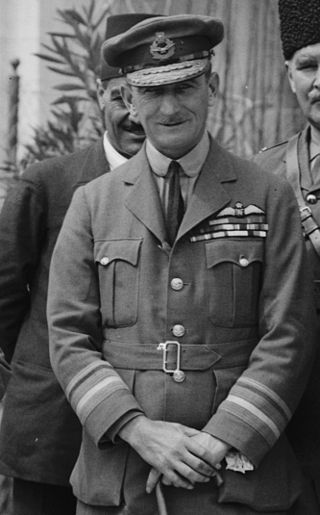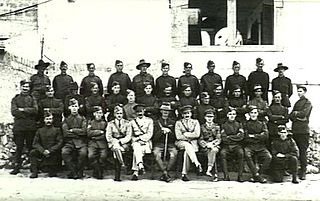Related Research Articles

The Royal Flying Corps (RFC) was the air arm of the British Army before and during the First World War until it merged with the Royal Naval Air Service on 1 April 1918 to form the Royal Air Force. During the early part of the war, the RFC supported the British Army by artillery co-operation and photographic reconnaissance. This work gradually led RFC pilots into aerial battles with German pilots and later in the war included the strafing of enemy infantry and emplacements, the bombing of German military airfields and later the strategic bombing of German industrial and transport facilities.

Number 1 Squadron, also known as No. 1 (Fighter) Squadron, is a squadron of the Royal Air Force. It was the first squadron to fly a VTOL aircraft. It currently operates Eurofighter Typhoon aircraft from RAF Lossiemouth.

Marshal of the Royal Air Force Sir Edward Leonard Ellington, was a senior officer in the Royal Air Force. He served in the First World War as a staff officer and then as director-general of military aeronautics and subsequently as controller-general of equipment. In the inter-war years he held command positions in the Middle East, in India and then in Iraq. He served as Chief of the Air Staff in the mid-1930s and in that role he implemented a plan, known as 'Scheme F'. This scheme implemented an increase in the size of the Royal Air Force to 187 squadrons within three years to counter the threat from Hitler's Germany. He also broke up the command known as "Air Defence of Great Britain" to create RAF Fighter Command, RAF Bomber Command, RAF Coastal Command and RAF Training Command. He then served as Inspector-General of the RAF until his retirement in 1940.

Marshal of the Royal Air Force Sir John Maitland Salmond, was a British military officer who rose to high rank in the Royal Flying Corps and then the Royal Air Force. During the First World War he served as a squadron commander, a wing commander and then as General Officer Commanding the RAF on the Western Front towards the end of the war. He went on to be Air Officer Commanding British Forces in Iraq in the early 1920s when he halted a Turkish invasion and sought to put down a Kurdish uprising against King Faisal, the British-sponsored ruler of Iraq. He was Chief of the Air Staff in the early 1930s and bitterly opposed the position taken by British politicians at the World Disarmament Conference in Geneva, which would have led to the UK's complete aerial disarmament. In the event the talks broke down when Adolf Hitler withdrew from the Conference in October 1933.

Air Chief Marshal Sir William Geoffrey Hanson Salmond, was a senior commander in the Royal Flying Corps during the First World War. Remaining in the Royal Air Force after the war, he held senior appointments in the Middle East, Great Britain and India. In late 1928 and early 1929, he directed the evacuation from Kabul of British embassy staff and others, by air.

The Air Member for Personnel (AMP) is the senior Royal Air Force officer who is responsible for personnel matters and is a member of the Air Force Board. The AMP is in charge of all aspects of recruiting, non-operational flying and ground training, career management, welfare, terms, and conditions of service, and resettlement for RAF regular, reserve, and civilian staffs worldwide.
The 13th Infantry Brigade was a regular infantry brigade of the British Army that saw active service during both the First and the Second World Wars.
The 8th Infantry Brigade was an infantry brigade of the British Army that saw active service in both the First and the Second World Wars, before being disbanded and reactivated in the 1960s. The brigade was finally being disbanded in 2006. It was formed before the First World War as part of the 3rd Division. As part of that division it spent the entire war on the Western Front from 1914 to 1918 in the First World War. The brigade was also active during the Second World War.

Air Vice Marshal Sir Charles Alexander Holcombe Longcroft, was a pilot and squadron commander in the Royal Flying Corps who went on to become a senior commander in the Royal Air Force. He was the first commandant of the RAF College, Cranwell.

Air Vice Marshal Amyas Eden Borton, was a pilot and commander in the Royal Flying Corps during the First World War and a senior commander in the Royal Air Force during the 1920s. He saw active service on the Western Front, in Palestine and in Iraq. In the latter part of his career, Borton was the second Commandant of the RAF College at Cranwell before becoming the Air Officer Commanding RAF Inland Area.
Air Vice-Marshal Sir Tom Ince Webb-Bowen, was a senior commander in the Royal Air Force during the first half of the 20th century.
Major General Edward Bailey Ashmore, was a British Army officer from the 1890s to the 1920s who served in the Royal Artillery, the Royal Flying Corps and briefly in the Royal Air Force before founding and developing the organisation that would become the Royal Observer Corps.
No. 5 Wing of the Royal Air Force was a wing of aircraft squadrons which was originally established as the Fifth Wing of the Royal Flying Corps. Currently inactive, the wing has been formed and disbanded five times over the course of its history.
The air commanders of World War I were army or navy officers who came to command air services during the first major conflict in which air power played a significant role.
The Palestine Brigade of the Royal Flying Corps, and later Royal Air Force, was formed 5 October 1917 in response to General Allenby's request for an air formation for his planned offensive against the Ottoman Empire in Palestine.

No. 40 Wing formed part of the Royal Air Force (RAF) Palestine Brigade during World War I and immediately after. It was established in October 1917 as 40th (Army) Wing, Royal Flying Corps (RFC), and become part of the RAF in April 1918, when the RFC merged with the Royal Naval Air Service. The wing played a major part in the Battle of Megiddo, the last great offensive against the Ottoman Empire, in September 1918. It was disbanded in April 1920.

Middle East Command was a command of the Royal Air Force (RAF) that was active during the Second World War. It had been preceded by RAF Middle East, which was established in 1918 by the redesignation of HQ Royal Flying Corps Middle East that had been activated in 1917 although a small Royal Flying Corps presence had been operational in the region since 1914.
The 226th Infantry Brigade was a Home Service formation of the British Army that existed under various short-lived titles in both World War I and World War II.
71st Division was a short-lived infantry division of the British Army during the First World War. It served in the Home Defence forces and never went overseas.
References
- ↑ Boyle, Andrew (1962). "Chapter 6". Trenchard Man of Vision. St. James's Place London: Collins. p. 157.
- 1 2 3 4 5 6 7 8 9 10 "Groups Europe_P".
- 1 2 3 4 "Groups RFC - Home_P".
- ↑ "T I Webb_Bowen_P".
- ↑ "Groups Middle East_P".
- ↑ Jefford, C. G. (2014). Observers and Navigators And Other Non-Pilot Aircrew in the RFC, RNAS and RAF. Grub Street. pp. 60, 228. ISBN 9781909808409.
- ↑ "C L Lambe_P".
- ↑ "Groups Middle East_P".
